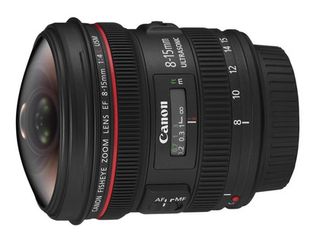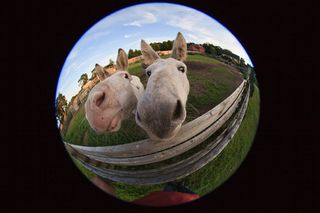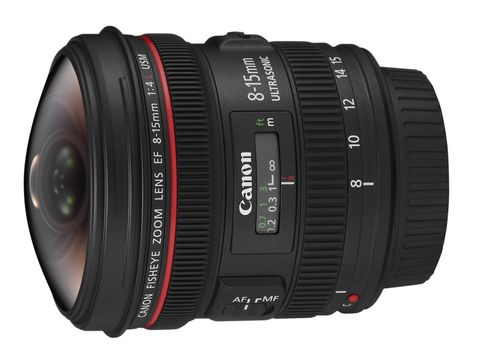TechRadar Verdict
A wonderfully versatile lens that enables you to switch between circular and diagonal fisheye effects with a twist of the zoom ring
Pros
- +
Dual circular and diagonal fisheye options on full-frame cameras
- +
very good image quality
- +
excellent L-series build quality and ring-type USM autofocus
Cons
- -
Lacks circular/diagonal versatility on APS-C and APS-H cameras
- -
fisheye distortion effect is minimised at 15mm on an APS-C camera
- -
very expensive for a fisheye lens
Why you can trust TechRadar
The fisheye camera lens was originally developed so that the whole sky could be captured in one single image to help meteorologists study cloud formations. However, the extravagant 180-degree angle of view soon found favour with photographers.
One thing that sets fisheye lenses apart from regular ultra-wide lenses is their curvilinear rather than rectilinear optics. This means that rather than aiming to keep straight lines straight, they exhibit extreme barrel distortion, bowing parallel lines – which you can use to creative effect. But what is it that makes the new Canon EF 8-15mm f/4L Fisheye USM so special?

Conventionally, you have to choose between two types of fisheye lens.
A circular fisheye produces a circular image that only covers the central portion of the sensor, leaving the remainder of the frame black.
The other option is a diagonal fisheye, which produces a larger image that covers the whole sensor, resulting in a more typical, full-sized rectangular picture. The unique thing about the Canon 8-15mm fisheye is that it produces a circular fisheye image at 8mm, stretching to a diagonal fisheye image at 15mm. Essentially, you get two lenses in one.

Canon EF 8-15mm f/4L Fisheye USM at 8mm - see full resolution image

Canon EF 8-15mm f/4L Fisheye USM at 15mm - see full resolution image
There's a catch, though – the EF 8-15mm is designed for full-frame cameras like the Canon EOS 5D Mark II, and you don't get the dual circular and diagonal fisheye options on cameras with smaller sensors. With Canon's APS-C cameras, such as the EOS 50D and 550D, you get full sensor coverage at 10-15mm focal lengths, and on APS-H cameras such as the EOS-1D Mark IV, which have slightly larger but not full-frame sensors, it's 12-15mm.
At 8mm focal lengths on APS-C D-SLRs, you'll merely get extreme vignetting (cropping of the corners) instead of a circular image. To help avoid this, there are C and H markings next to the zoom ring, as well as a zoom limit switch for APS-C cameras, locking the zoom range at 10-15mm. Another disappointment is that, at the 15mm end on APS-C cameras, the bowed fisheye distortion effect is rather minimised.
As an L-series (Luxury) lens, the EF 8-15mm boasts fully professional, robust build quality. Features include a constant f/4 maximum aperture that's available throughout the zoom range, environmental seals to guard against moisture and dust and fluorine coatings on the front and rear elements to enable easy cleaning.
That's a bonus, because the protruding, dome-shaped front element is very exposed to the weather. Plus, the supplied lens hood can only be used at 15mm, otherwise it cuts into the corners of the image.
Ring-type USM (Ultrasonic motor) autofocus is super-fast and practically silent, complete with full-time manual override. Measuring 78.5x83mm and weighing 540g, it's rather larger and heavier than Canon's now obsolete EF 15mm f/2.8 fisheye prime lens, but still smaller and lighter than the regular EF 16-35mm f/2.8L ultra-wide full-frame lens.
In our tests, sharpness proved very impressive, especially between f/5.6 and f/11. The lens is also remarkably resistant to ghosting and flare, helped by the use of Canon's Subwavelength structure coating (SWC). That's good news, because you often capture a vast expanse of bright sky when using a fisheye lens outdoors.
As with other circular fisheye lenses, we often got a blue edge around the circumference of the image in circular fisheye mode, but it's quite easy to apply a circular crop in Photoshop to fix this. Colour fringing around high-contrast edges was also quite noticeable, but you can shoot in RAW and tune these out in the Digital Photo Professional software supplied with your Canon camera.
Verdict
On a full-frame camera such as the EOS Canon 5D Mark II, the EF 8-15mm Fisheye is a wonderfully versatile lens that enables you to switch between circular and diagonal fisheye effects with a twist of the zoom ring. Image quality is very good in terms of sharpness, contrast and resistance to ghosting and flare, although colour fringing can be quite noticeable.
For APS-C cameras, the lens is relatively poor value. Image quality is retained but versatility is lost.
It merely becomes a diagonal fisheye lens with reduced zoom range, and the heavily distorted fisheye effect is largely lost at the long end of the zoom range on an APS-C camera.
Ultimately, if you're shooting with a camera such as the Canon EOS 1100D, Canon EOS 600D, Canon EOS 60D or Canon EOS 7D, you're better off with either the Sigma 4.5mm f/2.8 EX DC HSM circular fisheye or the Sigma 10mm f/2.8 EX DC HSM diagonal fisheye, both of which are designed specifically for APS-C cameras and only cost about half the price.

